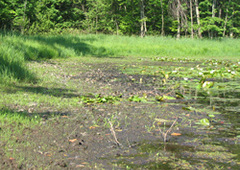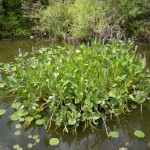Project: Wetland Plants & Drought Benefits
By Peter Ziegler, Project Director:
June is upon us and recent rains have helped retain and fill those seasonal wetlands both here in Wisconsin and across much of the prairie pothole region. This will definitely be a big help to nesting waterfowl. Seasonal wetlands are extremely important to waterfowl for a variety of reason and one of the biggest reasons is they dry up periodically, producing food and cover, which then become inundated, providing a buffet of food and cover during runoff events.
 Wetlands, where water is held constant for many years in a row, have a decrease in plant and wildlife diversity. Wetlands’ natural cycle of periodic drying is important. Even larger marshes need to be allowed be rejuvenated through water control management. Now is the time if this is on your mind. Slow drawdowns, which expose mudflats (as shown at left) during the growing season, and post spring runoffs allow a diversity of annual plants to grow.
Wetlands, where water is held constant for many years in a row, have a decrease in plant and wildlife diversity. Wetlands’ natural cycle of periodic drying is important. Even larger marshes need to be allowed be rejuvenated through water control management. Now is the time if this is on your mind. Slow drawdowns, which expose mudflats (as shown at left) during the growing season, and post spring runoffs allow a diversity of annual plants to grow. 
Plants such as pickerel weed (shown at right), bidens, plantain, etc,. provide an abundance of seed desired by waterfowl come fall. Slow is the key, as you want to keep the soil wet and only expose small amounts at a time. A draw down should take 1-2 weeks to complete properly.
This time also offers resident wildlife the ability to adjust and spreads out the growing season across a wetland. Come fall these area can be re-flooded, providing access to the food that waterfowl love. Slow again is the key, and remember: ducks only need 2-6 inches of water in the vegetation for feeding.
The most important thing to remember is that prior to flooding, the plants should have flowered and begun to set seed. If you flood too fast, too early, or too deep you will compromise the food source and ultimately the waterfowl response. You need to let the seeds develop so that the next time you do management to benefit your wetland the seed bank will have been replenished.
No matter how many ducks use an area, many seeds will find their way to the bottom and lay dormant, just waiting for the next drying period, after which your wetland will reward you with an attractive food source and draw in birds for your recreational benefit.
